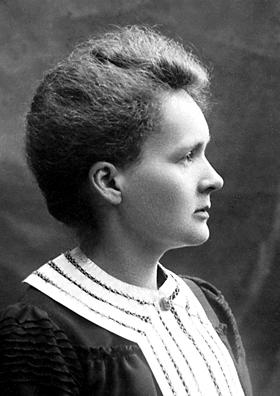So what’s the deal with Marie Curie’s laboratory notebooks? I recently read a question on an internet Q&A website asking how they can still be dangerous after a century and claiming that even touching the pages can put one at risk. But I’ve got to admit to being dubious – my background in radiation safety tells me that it’s not very easy to contaminate anything so much as to make it dangerous…especially through incidental contacts, such as writing or turning pages. And even more so when it’s radium that’s the contaminant – radium emits alpha particles (which can’t even penetrate through a piece of paper) and relatively low-energy gammas. But that’s just my guess – luckily, there’s some information on the matter, so we don’t have to guess.
The reason for the concern is that Marie and Pierre Curie processed tons of uranium-bearing minerals in their laboratory, discovering the naturally radioactive elements polonium and radium through an arduous process of grinding tons of rock and painstakingly extracting the radioactive components. They were doing this work only a few years after the discovery of radiation and radioactivity, and little was known of the potential harm they could cause. Even less was known about good radiological work practices – it’s not surprising that the laboratory and notebooks became contaminated.
Considering radium’s 1600-year half-life and the sensitivity of today’s radiation detectors, it’s equally unsurprising that this contamination is still detectable today. Oh – and if you’re interested, you can see Marie Curie’s notebook yourself – it’s in the Wellcome Collection (located in London), and anybody can download a scan as a PDF. Scholars can handle the notebook, although the Christian Science Monitor tells us that they first need to sign a release and use gloves because of the contamination.
But before we make an appointment to see the notebooks, let’s talk about the risks!
Contamination
In 2014 the Wellcome Trust commissioned an evaluation of contamination and radiation levels from Marie Curie’s notebook – the highest levels of contamination found were about 2500 counts per second (cps) of alpha contamination and 3500 cps of beta contamination. Further analysis (and a little bit of calculation) showed that the notebook has about 1.6 microCuries of radium-226 on the covers and about twice this amount of activity through the entire notebook. According to the Nuclear Regulatory Commission, a person can ingest up to 2 microCuries annually without exceeding a dose limit – this means that someone who decided to eat Marie Curie’s laboratory notebook would exceed their annual dose limit by about 60% for that year.
Is this a lot of radiation exposure? Well…it depends on how you look at it. It’s more than I’d want someone to receive in a year, if only because we try not to let anybody exceed a radiation dose limit. Having said that – do we expect that anybody is going to lick the front and back covers, or to eat, Marie Curie’s notebook? It seems unlikely – but even if they did, there’s not enough radioactivity to cause radiation sickness in the short term or create a significant risk of cancer in the long term.
The bottom line is that this notebook doesn’t pose an appreciable risk to anybody who wants to read it – even if they do decide to lick the cover and pages. In reality, the likely radiation exposure from handling the diary is even lower – at most, about 0.0003 microCuries might be removed by holding the notebook. Were this to be ingested (perhaps by licking one’s fingers or transferring it to a sandwich), one might receive a dose equivalent to the same amount of exposure we receive from natural radiation in just two days.
Radiation exposure
Radium primarily emits alpha radiation, which can’t even pass through a half-inch (about 1 cm) of air and cannot penetrate through the dead layer of skin cells of our epidermis to reach the living cells beneath. Radium also gives off a small amount of gamma radiation, but the low levels of radium measured in Curie’s notebook give off equally low levels of gamma radiation. Someone turning the pages wouldn’t receive enough radiation exposures to cause any health concerns. So, neither staff nor visiting scholars are at risk from reading or handling this document.
Marie and Pierre Curie’s remains
Marie Curie’s body (Pierre’s as well) was somewhat radioactive at the time of her death due to the radium and other radioactivity she had inhaled and ingested during her many years of laboratory work. As a result, she and Pierre were buried in lead coffins to shield the radiation both were emitting at the time of their death. In 1995 France honored both Marie and Pierre by moving their bodies to the Pantheon, where they were to be laid to rest with Victor Hugo, Jean-Jacques Rousseau, Voltaire, and other great French intellectuals. At this time, the French radiation protection agency (l’Office de Protection contres les Rayonnements Ionisants – OPRI) directed that radiation measurements be made during the exhumation to determine the risk, if any, to those involved in the process.
Radiation dose rates in the cemetery were slightly elevated, but this was determined to be due to natural radioactivity in the granite headstone, monuments, and pavers. Pierre Curie’s body was found to emit elevated radiation levels (about 0.24 µSv/hr – about 24 µR/hr), which is hardly enough to pose a risk to anyone. Marie’s emitted even less, most likely because of improved work safety practices as well as the elimination of radium from her body in her later years.
The amount of radium in Pierre’s remains was determined to be about 0.008 microCuries per kg [1]. Still, there’s no way to know how the radioactivity was distributed through his body (radium tends to concentrate in the bones) or if the measurements are representative of actual radium concentrations or only parts of his body. However, the average human skeleton weighs about 10 kg; if we assume for the sake of argument that Pierre’s skeleton contained about half the mass of his remains, then the total amount of radioactivity in Pierre’s body would have been about 0.16 microCuries – this number is almost certainly wrong, but there’s no way to tell if it’s high or low. If we multiply by a factor of 10 for the high estimate and divide by the same amount for the low estimate, it seems safe to say that Pierre had somewhere between 0.016 and 1.6 microCuries of radioactivity at the time of his death. The high estimate is still lower than what US regulations permit a radiation worker to ingest annually and would give a radiation dose of about 40 rem to the surface of the bone or about four rem to the whole body.
Given the relatively long half-life (about 1600 years) of radium, there has been virtually no radioactive decay between the time of the Curies’ death and today – if there’s very little radioactivity today, then there was very little at the time of their death. Given what was known at that time about their work, it likely made sense to bury both Marie and Pierre in lead-lined coffins – given the more recent measurements (1995), this seems to have been overly protective.
Conclusion
Marie and Pierre Curie worked with large amounts of radioactivity in their laboratory in an era when laboratory safety and radiation safety practices were rudimentary. As a result, both were almost certainly contaminated with radioactivity inside and out. But the contamination left behind on their laboratory notebooks and the radioactivity inside their bodies does not seem to have posed a risk to others at the times of their death, nor does it pose a threat to others today.
[1] The Radioactive Remains of Pierre and Marie Curie. The Invisible Light: The Journal of the British Society for the History of Radiology July 2013




